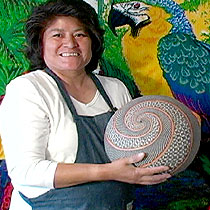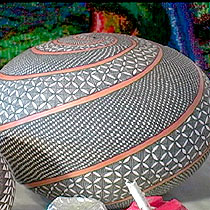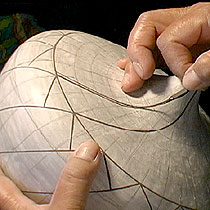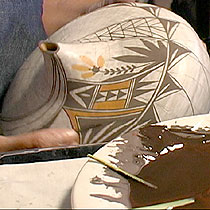2007年VOA标准英语-Acoma Pottery's Geometric Designs Complex, Uniq(在线收听)
Santa Fe, New Mexico
27 August 2007
The western U.S. state of New Mexico has 19 Pueblo tribal communities, some of them among the oldest American Indian settlements in the United States. Many of them are well known for their pottery, and among the best known is Acoma Pueblo pottery with its distinctive black and white, geometric designs. Producer Zulima Palacio recently spent time with a well-known Acoma potter and prepared this story. Deborah Block narrates it.
 |
| Sandra Victorino |
Victorino says it took her a long time to perfect her own style and designs.
 |
| Geometric patterns are a hallmark of her pottery |
After Victorino shapes the pots, her sons help her place them out under the desert sun to harden. "This are all the different colors I have here, you have to dig them out of the ground."
And from the yucca shrub -- common in the New Mexico desert -- Victorino gets her best brushes. Yucca is very much like the stringy parts of celery.
"This is only two strands of Yucca … I usually cut it in half and then soften them like this," she demonstrates. "This lasts me a long time, maybe three months."
 |
| All design work on the pottery is done by hand |
For hours -- often days -- Victorino sits quietly, painting her pots. One line at a time, the designs take shape; the colors, the forms often ripe with tribal myth and religious meaning. "Long time ago they were used for storing corn seeds and for planting. They called them the seed pots."
 |
| Painting the pottery |
Andrea Fisher is an authority on American Indian pottery. "American Indian pottery is looked upon by us, the outsiders of the culture, as beautiful objects but it goes much deeper than that. They are so connected to the culture and the religion."
Whether such art is fully understood or not, its baffling beauty is obvious, the complexity of its design inspiring. It is an American original.